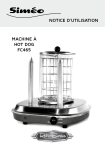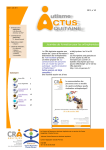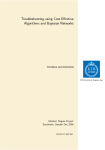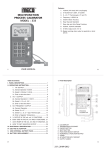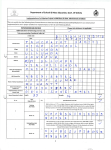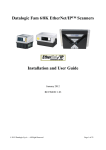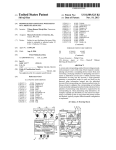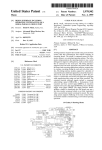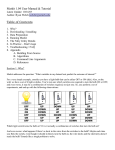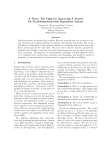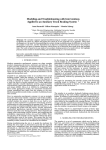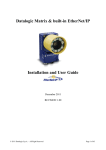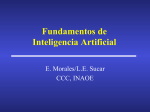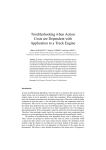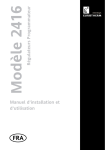Download Authoring tool for bayesian network diagnostic systems
Transcript
US007016056B2
(12) United States Patent
(10) Patent N0.:
US 7,016,056 B2
(45) Date of Patent:
Mar. 21, 2006
Skaanning
(54)
AUTHORING TOOL FOR BAYESIAN
(58)
NETWORK DIAGNOSTIC SYSTEMS
Field of Classi?cation Search ............... .. 358/1.1,
358/114, 1.13, 1.18; 706/46, 47, 50, 55,
706/59, 61
See application ?le for complete search history.
(75) IIlVeIltOfI Claus Skaanning, Dronninglund (DK)
(73) Assignee: Hewlett-Packard Development
Company, L.P., Houston, TX (US)
(56)
(*)
4,965,742 A * 10/1990 Skeirik ...................... .. 700/86
5,596,712 A * 1/1997 Tsuyama et al. ............ .. 714/26
_
_
* cited by examiner
Notice?
US. PATENT DOCUMENTS
Subject to any disclaimer, the term of this
patent is extended or adjusted under 35
U.S.C. 154(b) by 928 days.
(21) Appl' NO‘: 09/738’716
_
(22) Filed:
Primary Examiner—Arthur G. Evans
(57)
Dec. 16, 2000
_
(65)
_
_
diagnostic system. The authoring tool includes a cause editor
interface, an action editor interface and a question editor
’
_
(51)
(52)
_
_
ABSTRACT
An authoring tool assists an author in building an automated
Pnor Pubhcatlon Data
Us 2002/0044296 A1
Apt 18 2002
interface. The cause editor interface alloWs an author to
Related US Application Data
(63)
References Cited
_
place, in a cause data structure, information pertaining to
_
causes. The action editor interface alloWs an author to place,
contlnuanon'm'part of apphcanon NO' 09/388>891>
in an action data structure, information pertaining to actions
?led on Sep' 2> 1999> HOW abandoned
2006 01
' )
that can be taken in response to the causes. The question
editor interface alloWs an author to place, in a question data
~
~
~ ~
~
structure, information pertammg to questions that can be
asked a user of the product to help identify causes.
US. Cl. ................................... .. 358/113; 358/1.18
32 Claims, 15 Drawing Sheets
Int. Cl.
606K 15 00
/
(
WEB SERVER
DIAGNOSTIC
SYSTEM
A
\
201
A
\
203
202 4
204 4
200
‘
‘
PRINTER
HT," SERVER
WEB-BROWSER
207
\
209
\ \
CUSTOMER PC 206
\
205
R
PRlNTER
208
210
U.S. Patent
Mar. 21, 2006
Sheet 1 6f 15
US 7,016,056 B2
WEB SERVER
DIAGNOSTIC
SYSTEM
‘
x
201
\
203
202
204 _
200
‘
&
PRINTER
K
WEB-BROWSER
207
SERVER
\
209
\
CUSTOMER PC 206
\
205
R
PRINTER
208
x
210
FIGURE 1
U.S. Patent
Mar. 21, 2006
Sheet 2 6f 15
US 7,016,056 B2
WEB SERVER
SECONDARY
STORAGE
DEVICE
MEMORY
I303
VIDEO
DISPLAY
DIAGNOSTIC
SYSTEM
I 304
I
201
INPUT
DEVICE
I305
CPU
301
\306
NETWORK
DRIVER/
CARD
f I307
\
j 200
CUSTOMER PC
FIGURE 2
205
U.S. Patent
Mar. 21, 2006
Sheet 3 6f 15
US 7,016,056 B2
WEB sERvER
f‘ 200
\
203 i 204 4
CUSTOMER PC
WEB-BROWSER
‘200
OPERATING SYSTEM
APPLICATION
l
‘406
PRINTER DRIVER
l
‘407
sPOOLER
413
\408
f
PRINTER\
sERvER 420
NETWORK
DRIVER
QUEUE
417
410
4 QEQB’ORK
‘410
‘411
O/S REDIREOT
414 PRINTER
, LOCAL
PORT
‘409
‘412
I
\
415
210
\405
205
FIGURE 3
I
209
U.S. Patent
Mar. 21, 2006
US 7,016,056 B2
Sheet 4 0f 15
IDENTIFY ISSUE
TO DIAGNOSE
__1
ESTIMATE
PROBABILITIES
i ‘900
FOR CAUSES AND
SUBCAUSES
IDENTIFYCAUSES
I \907
OF THE ISSUE
I ‘901
ESTIMATE
PROBABILITEES
FOR ACTIONS
AND QUESTIONS
IDENTIFY
SUBCAUSES
902
I \908
IDENTIFY
DIAGNOSTIC STEPS
ESTIMATE COSTS
FOR ACTIONS
AND QUESTIONS
I ‘909
I ‘903
IDENTIFY ACTIONS
AND QUESTIONS
REQUIRING SPECIAL
HANDLING
MATCH CAUSES &
DIAGNOSTIC STEPS
‘910
ANY
DIAGNOSTIC
STEPS MISSING?
NO
YES
906
FIGURE 4
U.S. Patent
Mar. 21, 2006
Sheet 6 6f 15
US 7,016,056 B2
Cause editor
Cause Editor
[>__Z|
Name: Boner cartridge
k/x/m
62 \F\El Subcause ol: F
lvl
Probability: [2E7]
Explanation
63
64
'v 65
Datatlow
66 ~r\l2l This cause is a consumable (toner cartridge, tuser, transfer
roler or feed and separation rollers).
67 \/y\t:l Automatic data collection possiale.
68 \IRU Can be fixed by rebooting the PC.
69 ~r\l:l Can be iixed by power cycling the printer.
Dependency of environment “?int-q.----------------------- --/\/ 78
'
Operating system
Printer driver
Network
Paper handling devices
Name of cause given to customers:
Deletecause
l
77
[15%
60 J
FIGUREG
U.S. Patent
Mar. 21, 2006
Sheet 7 6f 15
US 7,016,056 B2
Cause probability editor
Cause Probability Editor
IX]
Select level and causes:
Environmental conditions out of spec
infuse-r............................. _-.l
‘
5
___F_i§§_r_.ir.te_<2tttr..t.iittr
Fuser sealed improperly........
Fuser worn out
Media out of spec
Other problem
L
Permanent problem
‘
Temporary problem solvable by cycling
Paper paih dirty
Toner Cartridge
Ton er cartridge detective
Toner cartridge improperly seated
//“\_d// 71
7
Set probabilities:
Fuser defective l dirty
84.29
Fuser seated improperly
i429
Fuser worn out
14.29
3:
Normalize
~70
OK
Cancel
FIGURE 7
U.S. Patent
Mar. 21, 2006
Sheet 8 0f 15
US 7,016,056 B2
Cause category editor
Categories of cause
vo‘iiéiaings'yseni
L ____________________ __.I
Select categories that the
cause falls into:
Consumables
Driver
Customer Expectat
Printer
Software
Cables
Settings
Network
Hardware
Application
Environment
OK
Cancel
FIGURE 8
W80
U.S. Patent
Mar. 21, 2006
US 7,016,056 B2
Sheet 10 0f 15
Extra information editor for actions
Extra information for actions
[2]
IPeriorm user maintenance
I
r Tits action mines the ioiowing actions: —-
—iiisaciionismiiiaiyexciisivewithieioiowmacion——
Clean inside oi prinier per user manual
Reseaiiuser
~/“\_/102
Reseaiiransier roller
\J_\~
103 ah
Eiiiisaciioncanoiiybepeiiomedaitea
Diiisaciioncanotiybeperiormedaiieia
speci?c question has been answered
wedic qiesiion has been answeieii
Question:
a
Question: Did ou recently periorm the user mainien
Siaie: [E3]
105\U\
“*104
Siaie: m
Etiiiiisacionispeiimmtiteioiowhg
miiisactim'ritidesmoviigacmipmmi,
qiesionsmiidbeixediiiiespeciiedsiata
andwiaisostivetepwbieniitis
conponeni was seated inoperiy.
Queen: vnwrewnnneimn
ieiiiiieii 1::13
Stale: m
U iiewiponenisiuidmibemved bank iipheeaiiemaiia @406
Dammit)‘
environment.
107 \P
J
__i?iinie_r_________________ __
time it
he‘.
Operating system
Primer driver
. . W cm W
nmneinnenmm
Network
iiitiii?li't'tiittit?t
Paper handling devices
mm m am PM
_J
iSSJi
119
118
FIGURE 10
U.S. Patent
Mar. 21, 2006
Sheet 11 6f 15
US 7,016,056 B2
Action prcbabiiity editor
Probability of action
Assuming that Transfer rolier
is the only cause oi Leading edge scatter
what is the probabiiity that correctly performing the step
Perform user maintenance
will solve the problem?
100
OK
FIGURE 11
Cancel
[1/ 1 10
U.S. Patent
Mar. 21, 2006
US 7,016,056 B2
Sheet 12 0f 15
General question editor
General question
120w
Name: [_Did you recently perform the user maintenance? 1
121 r’ ,-_\_//
Probability changes for causes:
5
5
28
7
122\
Add State
1251\
Normalize
126%
W
123~q
Expfanation
124M
Edit costs,
l25-~_|
126 _
127%
Terrporary problem solvable by cycling powe A
Environmental conditions out of spec
Media out of spec
Transfer roler
l3
Transfer roler worn out
3 -> 25 Transfer roller improperly seated
85
Transfer roller defective l dirty
Fuser
4
Fuser worn out
B4
Fuser detective l dirty
1 -> 15 Fuser seated improperly
t
Remove chan e
Extra information
In Question is forced as number:
E
Remove question
FIGURE 12
Probability change editor
iZl
Probability Change Editor
Question: [Did you recently perform the user mail/w 132
Cause: ?ransfer roller improperly seated
‘E/Mh/ 131
State: {IE/V 133
Old probability:
l:
New probability:
Q @Il
FIGURE 13
R
[IE
\ia
U.S. Patent
Mar. 21, 2006
Sheet 14 0f 15
US 7,016,056 B2
Cause editor for actions and questions
Cost Editor
152 \
Step:
\_/_\
Time:
'
El
Perfarm user maintenance
25
-
(minutes)
'
I
Risk.
High
Money:
0
Insult:
0
inaccuracy:
Medium
4
153
|
J
‘J-—c/J\ 154
I}
\/—\ 155
'
'
I
I
151 /
OK
Cancel
FIGURE 15
I
U.S. Patent
Mar. 21, 2006
Sheet 15 of 15
US 7,016,056 B2
Explanation editor for causes, actions and questions
Explanation Editor
E]
Toner cartridge
Explanation:
E‘.
KWV 161
_._l
V
Note:
.6.
/—R/ 162
7
OK
Cancel
FIGURE 16
US 7,016,056 B2
1
2
AUTHORING TOOL FOR BAYESIAN
NETWORK DIAGNOSTIC SYSTEMS
most similar. The most similar cases are then investigated to
?nd the best next action or question that has the highest
likelihood to rule out as many cases as possible. This
CROSS REFERENCE TO RELATED
APPLICATION
continues until the single case that matches most the current
situation is determined.
Case-based systems gather cases that are descriptive of
the troubleshooting domain and use these cases to suggest
actions and questions that as quickly as possible narroWs the
This application is a continuation-in-part of application
Ser. No. 09/388,891, ?led Sep. 2, 1999 noW abandoned.
BACKGROUND
10
scope doWn to a single case. The quality of a case-based
system hinges on its case database Which has to be very large
to adequately describe a printer system domain. The possible
con?gurations/cases in a printer system are 2” for N vari
The present invention pertains to support of products and
pertains particularly to an authoring tool for Bayesian net
ables (1024 for 80 variables), if all the variables are binary.
Work diagnostic systems.
Currently, it is highly expensive for printer manufacturers
A subset of cases out of these Would have to be extremely
large to be suf?ciently descriptive to be useful to a case
to diagnose the systems of their customers. Typically, a
customer calls a printer call agent at the manufacturer. This
based system. Thus, it is doubtful that case-based systems
Will be successful in representing the printing system With
call agent guides the customer through a troubleshooting
sequence that leads to resolution of the problem or identi
?cation of the cause. This method requires the intervention
of a call agent Which results in a high cost.
its many variables to an optimal level of accuracy.
Rule-based systems can also be used to provide auto
20
When using call agents the printer manufacturer hires
be represented With Bayesian netWorks. They have a subset
many call-agents Which the customer in turn can call When
of the modeling capabilities of Bayesian netWorks, and the
he experiences problems With his printer system. The call
agent attempts to gather as much information as possible by
intervieWing the customer over the phone. When he reaches
the conclusion, he Will either have solved the problem,
25
30
that are not optimal When there are loops in the model.
Loops are very common in models of real-World systems
(e.g., common causes, troubleshooting steps that ?xes sev
eral causes, etc.).
One troubleshooter based on Bayesian netWorks is
described by Heckerman, D., Breese, J ., and Rommelse, K.
and types of troubleshooting steps used by different call
agents. It is a problem if customers are not given approxi
mately the same troubleshooting steps in the same order
With similar problems, as they may then feel confused. Also,
belief updating methods are not guaranteed correct as they
are With Bayesian netWorks.
Rule-based systems, hoWever, have updating methods
identi?ed the cause, or had to dispatch a ?eld agent that Will
attempt to resolve the problem at the customer site.
One draWback of using call-agents is the expense. In
addition, there can be problems With consistency in the order
mated diagnosis of printer systems. Rule-based systems can
be perceived as a subset of Bayesian networks, as they can
(1995), Decision-theoretic Troubleshooting, Communica
35
tions of the ACIVI, 38:49—57 (herein “Heckerman et al.
the call agent solution alloWs only limited logging of infor
1995”).
mation, has only limited integration of programmatic data
ABayesian netWork is a directed acyclic graph represent
ing the causal relationships betWeen variables, that associ
collectors, and very limited integration of multi-media pre
sentations. Use of call-agents hoWever, does provide the
bene?t of human-to-human communication betWeen the call
agent and the customer as the call agent Will obviously be
able to detect soft information that a computer-based system
cannot easily detect, such as, e.g., Whether the customer is
irritated With some line of questioning, the level of experi
40
ence of the customer, and so on.
45
of printer systems. The decision-tree approach speci?es the
possible troubleshooting sequences as a so-called decision
tree. At each branching of the tree, one of the branches Will
be chosen based on the information provided by the cus
tomer at the last step. HoWever, decision-trees are static in
the sense that for practical reasons it only alloWs a limited
4:269—282 (1990). Ef?cient methods for exact updating of
probabilities in Bayesian netWorks have been implemented
in the HUGIN expert system. See Andersen, S. K., Olesen,
K. G., Jensen, F. V. and Jensen, F., HUGIN—a Shell for
Building Bayesian Belief Universes for Expert Systems,
number of possible sequences of the troubleshooting steps.
decision tree is exponential in the number of these, it is only
Royal Statistical Society, Series B, 50(2):157—224 (1988),
and Jensen, F. V., LauritZen, S. L., and Olesen, K. G.,
Bayesian Updating in Causal Probabilistic Networks by
Local Computations, Computational Statistics Quarterly,
Decision trees can be used to provide automated diagnosis
With decision-trees all sequences that should be available to
the customer have to be encoded and as the siZe of the
ates conditional probability distributions to variables given
their parents. Ef?cient methods for exact updating of prob
abilities in Bayesian netWorks have been developed. See for
example, LauritZen, S. L., and Spiegelhalter, D. J. Local
Computations With Probabilities on Graphical Structures
and their Applications to Expert Systems. Journal of the
55
Proceedings of the Eleventh International Joint Conference
on Arti?cial Intelligence. (1989).
Bayesian netWorks provide a Way to model problem areas
possible to encode a limited number of them. This on the
average Will cause the decision tree to provide longer
using probability theory. The Bayesian netWork representa
troubleshooting sequences With loWer probability of actually
subset of variables given information on others. A Bayesian
diagnosing the problem, as it is not possible to take all
possible scenarios into account.
Case-based reasoning can also be used to provide auto
netWork consists of a set of variables (nodes) and a set of
mated diagnosis of printer systems. The case-based
together With the directed edges form a directed acyclic
tion of a problem can be used to provide information on a
directed edges (connections betWeen variables). Each vari
able has a set of mutually exclusive states. The variables
approach gathers a high amount of descriptive cases from
graph (DAG). For each variable v With parents W1, . . . , Wn,
troubleshooting scenarios Where various problems are seen.
65 there is de?ned a conditional probability table P(vlwl, . . . ,
Based on information about the current situation, the case
based reasoning engine can then select the cases that are
Wn). Obviously, if v has no parents, this table reduces to the
marginal probability P(v).
US 7,016,056 B2
3
4
Bayesian networks have been used in many application
domains with uncertainty, such as medical diagnosis, pedi
TABLE 2
gree analysis, planning, debt detection, bottleneck detection,
Step 1:
etc. However, one of the major application areas has been
Compute the probabilities of component faults p; given
that the device is not functioning.
diagnosis. Diagnosis (i.e., underlying factors that cause
diseases/malfunctions that again cause symptoms) lends
itself nicely to the modeling techniques of Bayesian net
Step 2:
Step 3:
Observe the component with the highest ratio pi/Ci".
If the component is faulty, then repair it.
Step 4:
If the device is still malfunctioning, go to step 1.
works.
The currently most efficient method for exact belief updating
of Bayesian networks is the junction-tree method that trans
forms the network into a so-called junction tree, described in
Jensen, F. V., LauritZen, S. L., and Olesen, K. G., Bayesian
Updating in Causal Probabilistic Networks by Local Com
putations, Computational Statistics Quarterly, 4:269—282
(1990). The junction tree basically clusters the variables
10
optimal troubleshooting sequence is higher than the cost of
a service call (e.g., calling the manufacturer for assistance).
The theory changes to the above plan that enables it to
approximately handle systems with multiple faults and non
15
such that a tree is obtained (i.e., all loops are removed) and
20
Decision-theoretic Troubleshooting: A Framework for
Repair and Experiment, Technical Report MSR-TR-96-06,
(1996) Microsoft Research, Advanced Technology Division,
tational Complexity of Probabilistic Inference using Baye
sian Belief Networks, Arti?cial Intelligence, 42:393—405,
Microsoft Corporation, Redmond, USA), the method is
(1990)), however, it is still very efficient for some classes of
Bayesian networks. The network for the printing system
base observations. Non-base observations are observations
on something that is not a component but potentially pro
vides useful information for the troubleshooting process. In
a companion paper (Breese, J. S. and Heckerman, D.,
the clusters are as small as possible. In this tree, a message
passing scheme can then update the beliefs of all unobserved
variables given the observed variables. Exact updating of
Bayesian networks is NP-hard (Cooper, G. E, The Compu
Heckerman et al. 1995 introduces a theory for handling a
service call that is used when the expected cost of the most
25
further advanced to also enable con?guration changes in the
system to provide further useful information that can poten
tially lower the cost of the optimal troubleshooting
contains several thousand variables and many loops, but can
still be transformed to a junction tree with reasonably
sequence.
ef?cient belief updating.
described by Heckerman et al. 1995 have a one-to-one
correspondence between causes and actions which does not
However, the Bayesian-network based troubleshooters
Heckerman et al. 1995 presents a method for performing
sequential troubleshooting based on Bayesian networks.
30
hold in reality, have myopic (one-step lookahead) selection
of questions, and have too slow selection of questions when
For a device to troubleshoot that has n components
represented by the variables c1, . . . , cn, Heckerman et al.
there are many of them. Furthermore, Heckerman et al. 1995
1995 follow the single-fault assumption that requires that
presents no method of knowledge acquisition for their
exactly one component is malfunctioning and that this
component is the cause of the problem. If pi the probability
that component ci, is abnormal given the current state of
troubleshooters.
35
SUMMARY OF THE INVENTION
information, then i=1”pi=1 under the single-fault assumption.
Each component ci has a cost of observation, denoted Ci0
(measured in time and/or money), and a cost of repair Ci’.
40
Under some additional mild assumptions not reproduced
here (see Heckerman et al. 1995 for more information), it
can then be shown that with failure probabilities pi updated
with current information, it is always optimal to observe the
component that has the highest ratio pi/Cio. This is intuitive,
In accordance with a preferred embodiment of the present
invention, an authoring tool assists an author in building an
automated diagnostic system. The authoring tool includes a
cause editor interface, an action editor interface and a
question editor interface. The cause editor interface allows
45
as the ratio balances probability of failure with cost of
observation and indicates the component with the highest
probability of failure and the lowest cost of observation.
an author to place, in a cause data structure, information
pertaining to causes. The action editor interface allows an
author to place, in an action data structure, information
pertaining to actions that can be taken to in response to
causes. The question editor interface allows an author to
place, in a question data structure, information pertaining to
Under the single-fault assumption, an optimal observation
repair sequence is thus given by the plan set out in Table 1
questions that can be asked a user of the product to help
identify causes.
below:
In the preferred embodiment, the authoring tool addition
ally comprises a library of modules, at least one of the
modules containing diagnostic information about a compo
TABLE 1
Step 1:
Compute the probabilities of component faults p; given
that the device is not functioning.
Step 2:
Step 3:
Observe the component with the highest ratio pi/Ci".
If the component is faulty, then repair it.
Step 4:
If a component was repaired, then terminate.
Otherwise, go to step 1.
55
60
In the plan described in Table 1 above, if a component is
nent of a product. The author can select modules from the
library of modules when building the automated diagnostic
system for the product.
For example, the information pertaining to causes relates
to the following categories: name of the cause, parent of the
cause, explanation of the cause, and probability of the cause
being present. The information pertaining to the cause may
repaired in step 3, it is known from the single-fault assump
additionally relate, for example, to the following categories:
tion that the device must be repaired, and the troubleshoot
cause category, dependency on environment, and indication
ing process can be stopped. The algorithm works reasonably
well if the single-fault assumption is lifted, in which case
step 1 will take into account new information gained in steps
2 and 3, and step 4 will be replaced as in Table 2 below:
that a customer is not to access this cause information.
65
The information pertaining to an action relates, for
example, to the following categories: name of the action,
explanation of the action, causes solved by the action,
US 7,016,056 B2
5
6
probabilities that the action solves speci?ed causes, and an
indication whether the action is for information-gathering or
is a potential solution. The information pertaining to the
action also may relate, for example, to the following cat
a change in a module can be propagated to all the places
where this module is used. Thus, time requirements for
maintenance of diagnostic system models are decreased
egories: an indication as to whether the action should be
taken before other actions, an indication as to whether the
The authoring tool allows swift migration from one
product to the next. As diagnostic information is arranged in
action is a workaround, costs of taking the action, trustwor
thiness of the answer to the action, additional actions
a diagnostic system for one product to the next by simply
greatly.
a modular manner, it is a quick and easy process to migrate
included with the action, whether the action can only be
performed after a speci?ed question has been answered, and
10
considering only the modules that have changed. With many
product series, there are only few changes between different
whether the action cannot be performed after a speci?ed
versions, different revisions and or different models. The
question has been answered.
The information pertaining to a question, for example,
relates to the following categories: name of the question,
Further, when creating initial diagnostic models for a prod
explanation of the question, number of answers, names of
required changes usually reside in clearly de?ned modules.
15
answers, and costs of answers. The information pertaining to
the question also may additionally relate, for example, to the
following categories: whether the question can only be
performed after a speci?ed question has been answered,
whether the question cannot be performed after a speci?ed
uct, information that is likely to change with the next model
can be ?agged. Thus when migrating these models, the
authoring tool can display the ?agged information for con
sideration by the domain expert. In this way time require
ments for migration can be decreased by the arrangement of
information in modules and ?agging of information likely to
change between models.
question has been answered, an indication as to whether the
The preferred embodiments of the invention allow the
question should be asked before other questions, and
knowledge acquisition to be performed by the people with
whether the question is a symptom question or a general
the knowledge of the domain, that is, the domain experts. No
question. When information pertaining to the question par
ticularly pertains to a symptom question, the information
may additionally relate, for example, to the following cat
expertise with Bayesian networks, diagnostic algorithms,
25
egories: causes of the symptom, probability of answers to
the question conditional on causes of the symptom, and
probability of answers to the question conditional on none of
etc., is necessary. Thus, the authoring tool described herein
allows the minimal labor possible to generate diagnostic
systems.
BRIEF DESCRIPTION OF THE DRAWINGS
the causes that can cause the symptom. When information
pertaining to the question particularly pertains to a general
FIG. 1 is an overview of a diagnostic environment in
question, the information may additionally relate, for
example, to the following categories: prior probabilities of
accordance with a preferred embodiment of the present
invention.
answers to the question, causes that are affected by answers
to the question, and probability of the affected causes
35
conditional on each answer to the question.
In the preferred embodiment, the cause editor interface
allows an author to create new cause entries and delete and
edit existing cause entries. The action editor interface allows
an author to create new action entries, and delete and edit
40
existing action entries. The question editor interface allows
an author to create new question entries, and to delete and
edit existing question entries.
An authoring tool in accordance with the preferred
embodiment of the present invention greatly decreases the
45
time requirements of knowledge acquisition. The authoring
series of questions that allows him to specify only the
FIG. 6 shows an interface for a cause editor in accordance
absolute minimum amount of information. The authoring
tool is structured such that information of the domain is
speci?ed in ways that are proven to be natural and intuitive
to the domain experts. The authoring tool is structured such
with a preferred embodiment of the present invention.
FIG. 7 shows an interface for a cause probability editor in
accordance with a preferred embodiment of the present
invention.
that knowledge of Bayesian networks is not required, thus,
FIG. 8 shows an interface for a cause category editor in
a Bayesian network expert is no longer required to be
process.
55
Also, initial construction of diagnostic models for error
dance with a preferred embodiment of the present invention.
FIG. 10 shows an interface for an action probability editor
will increase as more and more modules in the domain will
be built.
The authoring tool allows swift maintenance of prior
constructed diagnostic systems. Prior to the existence of the
authoring tool, direct manipulation of the underlying Baye
sian network was required to modify the behavior of a
diagnostic system. However, with the authoring tool, the
more suited to the purpose. Further, due to reuse of modules,
accordance with a preferred embodiment of the present
invention.
FIG. 9 shows an interface for an action editor in accor
conditions in the domain in question will be relatively slow,
however, through the reuse of modules the authoring speed
required changes can be performed on a representation much
FIG. 5 shows a main interface for an authoring tool in
accordance with a preferred embodiment of the present
invention.
tool is structured such that the author is guided through a
present during the knowledge acquisition
FIG. 2 is a simpli?ed block diagram of a web server in
accordance with a preferred embodiment of the present
invention.
FIG. 3 is a simpli?ed block diagram of components within
a customer personal computer used in the diagnostic process
in accordance with a preferred embodiment of the present
invention.
FIG. 4, is an overview of steps to perform knowledge
acquisition in accordance with a preferred embodiment of
the present invention.
65
in accordance with a preferred embodiment of the present
invention.
FIG. 11 shows an interface for a general question editor
in accordance with a preferred embodiment of the present
invention.
FIG. 12 shows an interface for a probability change editor
in accordance with a preferred embodiment of the present
invention.
US 7,016,056 B2
7
8
FIG. 13 shows an interface for a symptom question editor
in accordance With a preferred embodiment of the present
invention.
FIG. 14 shoWs an interface for an explanation editor in
accordance With a preferred embodiment of the present
invention.
abilities for actions and questions set out in the
informational steps and costs for actions and questions set
out in the informational steps. Causes correspond to selec
tions. Informational steps correspond to diagnostic steps and
are used to gather information useful for narroWing in on a
selection.
In classi?cation, a diagnostic system can be used to
FIG. 15 shoWs an interface for a cost editor in accordance
FIG. 16 shoWs an interface for an eXtra information editor
classify something according to a number of categories. For
eXample, the diagnostic system can be used for path analy
in accordance With a preferred embodiment of the present
invention.
sis, e.g., directing customer feedback e-mails to the correct
person. Directing customer feedback e-mails to the correct
With a preferred embodiment of the present invention.
person could entail, for eXample, classifying an e-mail into
DESCRIPTION OF THE PREFERRED
EMBODIMENT
one of a number of categories, based on tags or keyWords
15
FIG. 1 is an overvieW of a diagnostic environment in
predictive systems. Basically, potential future causes are
modeled instead of current causes, and questions that look
for symptoms of future problems are modeled.
accordance With a preferred embodiment of the present
invention.
FIG. 1 shoWs a Web-server 200, a customer personal
Brokering is a variant of selection Where a diagnostic
system is used to broker among a list of possible solutions.
For eXample, an e-speak broker that needs to perform a more
intelligent brokering betWeen competing e-services can use
a diagnostic system to do this by carrying out a more
computer (PC) 205, a printer server 209 and a printer 210.
Aprinter system diagnostic system 201 runs on a Web-server
200.
A diagnostic system is used, for example, for decision
support, selection, classi?cation, prediction, and or broker
ing.
eXtracted from the e-mail.
In prediction, a diagnostic system can be used to create
intelligent comparison of e-service parameters.
25
In decision support, a user is taken through a sequence of
Printer diagnostic system 201 is used herein as an
eXample of a diagnostic system. Printer diagnostic system
201 is used for diagnosing operation of a printing system. A
questions leading him to the optimal solution to a problem.
For eXample, decision support aids a user in making the right
decision With regard to some problem. For eXample, a
system for automated customer support operations
(SACSO) decision support engine uses a sequence of ques
tions to determine the true underlying problem, and can then
suggests solutions to the problem.
user on customer PC 205 can access diagnostic system 201
over Internet 202. A Web-broWser 206 Within customer PC
205 is used to access Web-server 200. In response to the
customer’s interaction With diagnostic system 201, diagnos
tic system 201 responds With suggestions 203 for diagnostic
steps that the customer can perform. Diagnostic system 201
To perform knoWledge acquisition used to provide deci
essentially functions as an eXpert system that utiliZes arti
sion support, a domain in Which to carry out the decision 35 ?cial intelligence. The customer provides information 204
support is identi?ed. Also identi?ed are possible situations
back to diagnostic system 201 Which informs diagnostic
Within the domain, possible sub-situations of the possible
system 201 on the outcome from acting on suggestions 203.
Information 204 may include information 207 the customer
obtains from printer server 209 and/or information 208 the
selections and informational steps. The informational steps
are matched to the possible situations and the possible
sub-situations. Probabilities are estimated for the possible
situations the possible sub-situations. Also estimated are
probabilities for actions and questions set out in the infor
mational steps and costs for actions and questions set out in
the informational steps.
In selection, a diagnostic system runs through a sequence
of questions that aids the user in selecting betWeen a number
of possibilities. Multiple selections can be made. For
eXample, a student uses the diagnostic system to design an
40
customer obtains from printer 210.
FIG. 2 is a simpli?ed block diagram of Web-server 200.
Diagnostic system 201 eXecutes in a memory 301 of Web
server 200. Diagnostic system 201 utiliZes secondary stor
age devices 303 for storage of diagnostic models. A video
45
display 304 can be used by a technician to monitor the
diagnostic process and to maintain the diagnostic models.
Web server 200 also includes an input device 305, such as
a keyboard, a CPU 306 and a netWork card 307 for com
munication With Web-broWser 206 in customer PC 205.
optimal curriculum of classes. By asking him questions, the
diagnostic system attempts to determine the areas Where the
FIG. 3 is an overvieW of the components of the diagnostic
student needs training (skills gap analysis), and the diag
process. Web-server 200 is shoWn. The customer commu
nostic system can then suggest classes that target these
speci?c areas. This is not completely general decision sup
nicates With diagnostic system 201 (shoWn in FIG. 1) Within
port. It is decision support in the manner that it aids the user
to identify the situation that the use is looking at, and then
suggests a solution. Causes correspond to situations. Infor
mational steps correspond to diagnostic steps. In this case
actions provide solutions, and questions gather information
like in a diagnostic system.
To perform knoWledge acquisition used to provide selec
55
Web-server 200 through Web-broWser 206 running on cus
tomer PC 401. The customer receives suggestions 203 from
diagnostic system 201 and in return provides ansWers 204.
The customer uses diagnostic system 201 When eXperienc
ing a malfunction in the printer system Which consists of
printer server 209 and printer 210. In general, When a
customer attempts to print from an application 406, the print
job ?rst goes to a printer driver 407, then through a local
tion, a domain in Which to carry out the selection is
identi?ed. Also identi?ed are possible situations Within the
spooler 408, if utiliZed, and then to an operating system
(O/S) redirect 409. 0/5 redirect 409 is the part of the
domain, possible sub-situations of the possible selections
operating system that determines Which Way the print job
and informational steps. The informational steps are
goes, i.e., to a netWork connection 413 via a netWork driver
matched to the possible situations and the possible sub
65 410 and a netWork card 411, or to a local port 412 in the case
situations. Probabilities are estimated for the possible situ
ations the possible sub-situations. Also estimated are prob
of a local parallel connected printer. If the print job goes to
a local parallel connected printer, the print job goes through





































